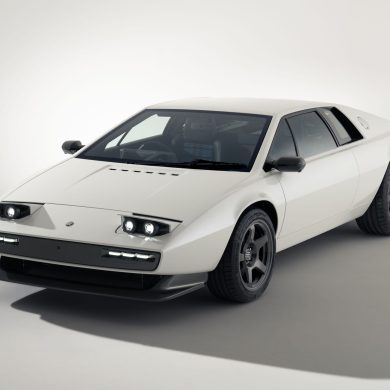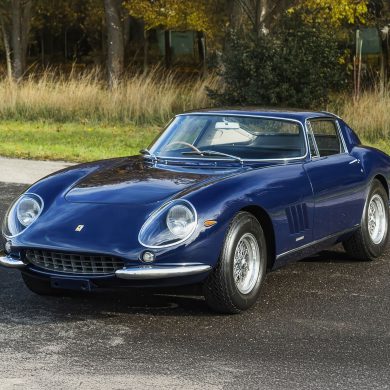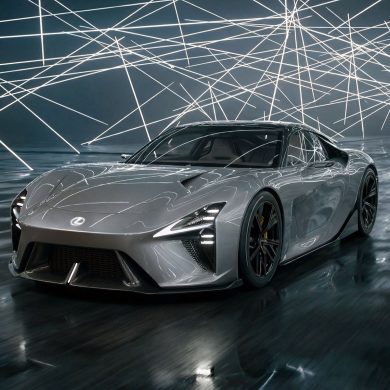
However, the road to this victory was by no means an easy one for Porsche. The Zuffenhausen sports car manufacturer had been racing at the Sarthe circuit since 1951, achieving numerous class wins thanks to intrinsic Porsche qualities such as lightweight construction, aerodynamics and reliability. In 1969, Porsche was pipped to the post in the closest ever Le Mans race, with Herrmann and Larrousse in the Porsche 908 finishing just 75 metres – around one second – behind the Ford GT 40 of Jacky Ickx.
In the anniversary year of 1970, all the signs pointed towards an offensive that would finally see the much longed-for overall victory in Le Mans go to Stuttgart. The Porsche 917 was destined for victory, having made its debut just a year earlier. On 21 April 1969, the 25 Porsche 917s were approved by the homologation commission in Zuffenhausen. The cost of materials alone exceeded DM 5 million. The Porsche 917, developed by Ferdinand Piëch, was unveiled at the Geneva Motor Show. This new ‘ultimate’ Porsche quickly caused a stir among rival competitors. Weighing in at close to the minimum weight of 800 kilograms, it went on to become one of the fastest and most successful racing cars of all time. The lightweight 12-cylinder engine delivered up to 580 hp at 8,400 rpm with a displacement of 4.5 litres. This enabled the long-tail version to reach speeds approaching 400 km/h (248 mph) on the 5,823 metre-long Hunaudières straight at Le Mans.
In the run-up to the 1970 race, it was clear that the lessons learned from previous years had been worthwhile. Realising that rash manoeuvres in the first few hours of this classic endurance race would ultimately end in failure, Porsche made the experienced Hans Herrmann its first choice as driver. The Sindelfingen veteran combined speed and good sense. Together with Englishman Richard Attwood, he started in the 4.5-litre short-tail version bearing the number 23, which was painted in the red and white colours of Porsche Salzburg. The team’s second car, featuring a 4.9-litre engine and long-tail body, was driven by Vic Elford and Kurt Ahrens. A further three Porsche 917s were entered by John Wyer along with the psychedelic-coloured 4.5-litre long-tail version of the Martini team. There was also an entire armada of 907, 908, 910, 911 S and 914/6 models. At precisely 4 p.m. on 13 June, 24 Porsche cars stood at the starting line in Le Mans. By the next day there were still 12 remaining, five of which were classified. The only other cars to be classified were two Ferrari 512 S – this was out of a total field of 51 starters.

This race went down in history – and not just from the perspective of Porsche – because of the disastrous weather. Vic Elford recalled how it was sometimes impossible to overtake, even on the long straights. Kurt Ahrens described it as being like sitting in a boat. And just a few weeks after his victory, Hans Herrmann admitted that driving in the rain had prompted him to make the decision to finally hang up his helmet no matter what the outcome. When leaving his house in Sindelfingen-Maichingen, his wife had asked him when he was going to give up driving, to which he responded: “When I win.”
A promise is a promise. An hour after the start, which saw the drivers begin the race sitting in their cars instead of performing the world-famous “Le Mans start”, Herrmann was only in ninth place. The race leader was Jo Siffert, also in a Porsche 917, followed by Jacky Ickx in a Ferrari 512 S. Siffert later missed a shift and blew his engine, while Ickx crashed his red racer at the chicane. At around 6:15 p.m. came the almost unbelievable news that four Ferrari 512 S had crashed into one another in the driving rain and were out of the race. The race also took its toll on the Porsche armada, with all three 917s of the Gulf team gradually dropping out.
Now was the moment for the experienced veteran Herrmann, who had the perfect partner in Richard Attwood, to show what he could do. Under the most difficult weather conditions, he gradually moved his way up the field, guiding the Porsche Salzburg 917 confidently to the first ever overall victory for Porsche at Le Mans. He realised the significance of this moment as the race came to an end on 14 June 1970: “Wow! That may have been your last lap ever as a racing driver.” Back home in Stuttgart, his victory was celebrated with a parade, in which he drove his winning car through the city to the market square. Thousands of people turned out to congratulate Hans Herrmann, ex-racing driver.
Porsche followed up this success with a further 15 overall victories at Le Mans, the second coming just a year later in 1971. In a unique Porsche 917 with a lightweight magnesium chassis, Gijs van Lennep and Dr. Helmut Marko drove to victory on a still largely chicane-free circuit. In doing so, they set an incredible record, which has never been broken. The Porsche 917 completed precisely 5,335.313 kilometres and 397 laps in 24 hours, clocking up an average speed of 222.304 km/h (138.140 mph) despite all of the pit stops and the long night. The fastest lap in the race was achieved by Jackie Oliver’s Gulf 917, with an unbelievable 244 km/h (151.6 mph) average speed, while the 917 long-tail Coupé of Elford/Larrousse was clocked at a maximum speed of 386 km/h (239.8 mph) on Hunaudières in 1971.

In 1976 and 1977 the Porsche 936 was victorious, while in 1981 it won again under Jacky Ickx and Derek Bell with a new turbo engine. Belgian driver Ickx won at Le Mans six times, four of them in a Porsche. In 1982 he was yet again part of the winning team in a triple victory that represented the first milestone for the most successful racing car of all time, the Porsche 956. Up to 1994, different variants of the 956/962 won at Le Mans seven times. 148 of these were produced in Weissach.

In some years, Porsche conceded the most important race of the year to customer teams, who emerged as frequent winners. Klaus Ludwig and the Whittington brothers thus achieved victory in Le Mans in 1979 with a Porsche 935 for the Cologne-based Kremer team, while Reinhold Joest guided the Porsche brand to well-deserved overall victories in 1984, 1985 and 1997.

Faced with the strongest ever field to line up at Le Mans in June 1998, Porsche racing director Herbert Ampferer spoke at the time of the “race of the century”. Porsche was represented with two new 911 GT1s and achieved a stunning double victory for the factory in the world’s most important endurance race, in front of a crowd of 250,000 thrilled spectators. This was the 16th and most recent overall victory for Porsche at the Sarthe circuit.

From 10 to 11 July 2010, Porsche will be celebrating this special motor sports anniversary in suitable style by taking part in the “Le Mans Classic”, an event which is only held every two years. In six classes covering model years 1923 to 1979, around 400 historic racing cars will gather to relive their old racing triumphs once more. Among them will be some of the overall winners from the Porsche Museum, which will lead an anniversary parade on the race track. Many famous drivers including Hans Herrmann and Richard Attwood will also be taking part and will be available for autograph sessions.
Porsche overall victories in Le Mans
1970
Hans Herrmann/Richard Attwood
Porsche 917 KH
1971
Helmut Marko/Gijs van Lennep
Porsche 917 KH
1976
Jacky Ickx/Gijs van Lennep
Porsche 936
1977
Jacky Ickx/Jürgen Barth/Hurley Haywood
Porsche 936
1979
Klaus Ludwig/Bill Whittington/Don Whittington
Porsche 935 K3 Kremer
1981
Jacky Ickx/Derek Bell
Porsche 936 81
1982
Jacky Ickx/Derek Bell
Porsche 956
1983
Al Holbert/Hurley Haywood/Vern Schuppan
Porsche 956
1984
Klaus Ludwig/Henri Pescarolo
Porsche 956 Joest
1985
Klaus Ludwig/Paolo Barilla/John Winter
Porsche 956 B Joest
1986
Derek Bell/Al Holbert/Hans-Joachim Stuck
Porsche 962 C
1987
Derek Bell/Al Holbert/Hans-Joachim Stuck
Porsche 962 C
1994
Yannick Dalmas/Mauro Baldi/Hurley Haywood
Dauer-Porsche 962 LM
1996
Manuel Reuter/Davy Jones/Alexander Wurz
TWR Joest-Porsche WSC95
1997
Michele Alboretto/Stefan Johannson/Tom Kristensen
TWR Joest-Porsche WSC95
1998
Allan McNish/Laurent Aiello/Stéphane Ortelli
Porsche 911 GT1 98
[Source: Porsche AG]










Hi Guys
Let’s not forget about the great class win for the 914GT. The stuff of legends!
And that 7th place 911S.
Cheers/Tim
Over the years I’ve read quite a bit about the Porsche 917. Interesting trivia such as, Porsche engineers had to cut a hole in the roof of their engine dyno room because during testing the air cooled engine gulped all the air from the room resulting in overheating. The tubular steel frame was prone to stress cracking so they filled the frame tubes with compressed air and ran a PSI gauge to the dash. If it lost air the driver knew there was a problem. The interior was allegedly rough, unfinished, and not very comfortable for tall drivers. And, it was a nightmare to see out the rear. All in all the 917 was a beast built in limited computer era out of non-high tech materials but boy did it ever make power and haul arse!
The wet 1970 race was my first Le Mans and I continued going for 30 years. For me the most memorable was the 1977 race when they took Jacky Ickx out of his failed car and put him in the last place 936 and told him, just go for it!
The drive of his life and a real pleasure to watch. I’m glad I was there to see it.